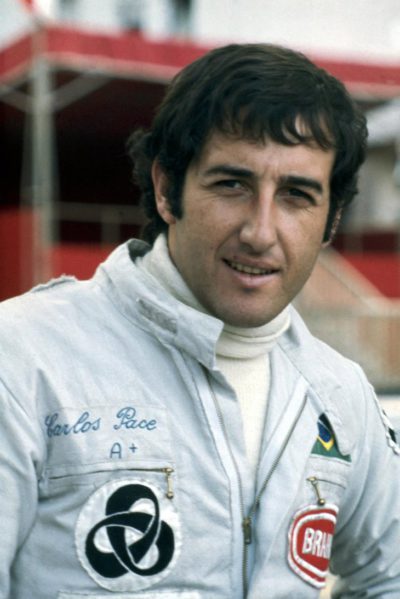Carlos Pace (Jose Carlos Pace)

Carlos Pace was a contemporary of the Fittipaldi brothers, Wilson and Emerson, and began racing in Brazil in the late 1960s. He travelled to Europe in 1970 and competed in British Formula 3, winning the Forward Trust championship in a Lotus car. In 1971 he moved up to Formula Two with Frank Williams, but did not score any points from six races. Nevertheless, he moved up to Formula One in 1972, competing with a Williams-entered March. He scored points on two occasions and finished eighteenth in the Drivers’ Championship. His best result came at the non-championship Victory Race, in which he finished in second position. He also competed in some further F2 and Can-Am races. For 1973, Pace moved to the Surtees team and improved to eleventh place in the championship after scoring a fourth place in Germany and his first championship podium finish with third in Austria. He also set the fastest lap in both of these events. He also competed in three F2 races for Surtees, but his main racing activities outside F1 were in the World Sportscar Championship, in which he drove for the works Ferrari team. Sharing a 312PB with Arturo Merzario, the duo finished second at the Nürburgring and at Le Mans (after starting in pole position for the latter event), and third at Watkins Glen. Carlos Pace remained with Surtees for 1974 and scored a fourth-place finish in Brazil, but parted company with the outfit mid-season after falling out with the founder, John Surtees. He drove a privately entered Brabham for Goldie Hexagon Racing at the French Grand Prix but failed to qualify, before moving to the works team alongside namesake Carlos Reutemann for the next race. After initially struggling with the new machinery, he finished fifth and set the fastest lap at Monza, and repeated the feat on his way to second, behind Reutemann, at Watkins Glen, securing a one-two finish for Brabham.
The Brabham team’s BT44B chassis were competitive throughout the 1975 season, allowing Pace and Reutemann to feature at the front of the grid. Pace duly took his first and only Formula One victory in front of his home crowd at the Brazilian Grand Prix, took his first pole position at the following race in South Africa, and also finished on the podium at Monaco and Silverstone, ending the season sixth overall in the Drivers’ Championship and helping Brabham to second in the Constructors’ Championship, behind Ferrari. Carlos Pace remained with Brabham for 1976, but the car was much less competitive due to a change of engine, from Ford-Cosworth to Alfa Romeo. The Italian V12 units were larger, heavier, less reliable and less economical than their V8 predecessors, restricting Pace to fourteenth place in the championship, whilst Reutemann left the team before the end of the season. By the start of the 1977 season, the competitiveness and durability of the Alfa engines had been much improved for Pace and his new team-mate, John Watson. He demonstrated this fact by taking second position at the season opener in Argentina, and running strongly in the next two Grands Prix before suffering from mechanical trouble, but he was unable to capitalise on the improved performance for the rest of the season due to his sudden death. Carlos Pace was killed in a light aircraft accident near São Paulo, Brazil on 18 March 1977, 13 days after fellow F1 driver Tom Pryce and marshal Jansen Van Vuuren lost their lives during the 1977 South African Grand Prix. The Interlagos track, the scene of his only F1 win in 1975, was renamed Autódromo José Carlos Pace in his honour. Pace is buried in Cemitério do Araça, São Paulo. In the 1977 motorsport film Bobby Deerfield, the eponymous title character is represented by Pace in the racing scenes.
Born
- October, 06, 1944
- São Paulo, Brazil
Died
- March, 18, 1977
- Mairiporã, Brazil
Cause of Death
- aircraft accident
Cemetery
- Cemitério do Araçá
- São Paulo, Brazil



